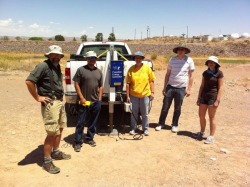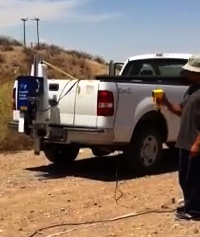PASSCAL Obtains New Automated Seismic Source
PASSCAL has purchased its first fully automated seismic source, a Propelled Energy Generator, model: PEG-40Kg manufactured by R.T. Clark Companies, Inc. The system is light weight, and highly portable, and is designed to easily mount onto a truck or SUV hitch. Seismic energy is produced when a large hammer mass weight is propelled by an elastomer band (i.e. a very large rubber band) onto an impact plate, producing an impact frequency range of 10-250Hz. The source is controlled with a hand held motor controller, and can operate in single cycle or continuous cycle mode. The device is powered by a 12V large capacity battery (car battery). The PEG-40Kg was received, assembled, and field-tested by PASSCAL staff on June 23rd-28th, 2011.
Here are pictures of the initial deployment of the new apparatus at the IRIS/PASSCAL Instrument Center. Click on any image to see a larger version.
|
IRIS/PASSCAL staff on hand for the debut of the PEG-40Kg Thumper: L-R, Mike Fort, Greg Chavez, Brit O'Neill, Patrick Bastien, and summer intern Jennifer Tarnowski. In this image, the unit is fully assembled: the blue gear box is in place, with white protective pieces shielding the rubber band, gears and chain. The top of the weight drop is secured with a strap to the truck bed. The white box Brit is holding connects a battery (in the truck bed) and the controller, which Greg is holding, to the motor in the gear box. |
|
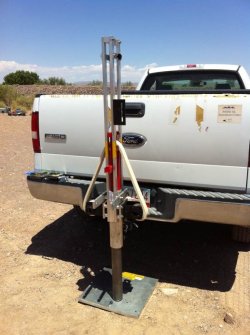 |
Here, the PEG-40kg is being mounted on the PASSCAL truck for its first test deployment. In this photo, the unit is partially assembled and attached to the hitch on the back of the pickup. The triangular object is a very hefty rubber band which accelerates the weight as it drops. The weight is the dark cylinder, resting on the strike plate, extending up through an aluminum sleeve and painted red on the upper half. |
|
In this picture, NMT Earth and Environmental Science Professor and PASSCAL PI Rick Aster (left) discusses the new device with visiting ExxonMobil representative C. Payton Todd and Jennifer Tarnowski. The gear box will sit on the aluminum arms that are sticking out in front of Rick's foot. The chain on the gear box has two pegs sticking out to the sides of it. As the chain travels over the gears, the pegs catch the little red extension sticking out from the weight, to the left of Rick's knee, and lift the weight to the top. When the chain travels over the top of the upper gear, the pegs are pulled away, and the weight is released. |
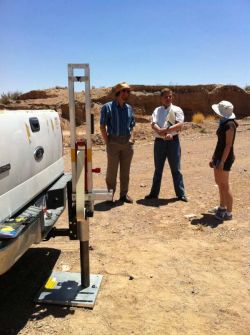 |
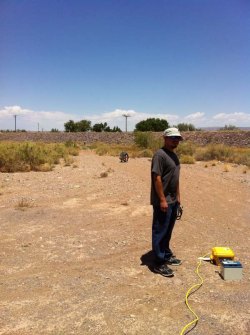 |
This image shows Greg Chavez, with Mike Fort several meters behind, and Jennifer Tarnowski in the far distance, laying out a string of geophones to record the Thumper's signal. |
|
This data plot shows the imparted force, in pounds, for five thumps of the new device. Here, the Thumper is packing around 25,000 pounds per wallop. |
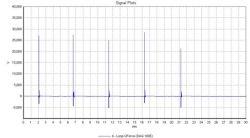 |
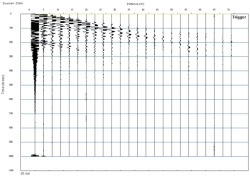 |
This "gather" plot for the line of geophones shows three stacked shots measured as intern Jennifer Tarnowski struck the heavy steel plate with a sledge hammer repeatedly. The data were recorded with a 24-channel Geode cable array, using 40-Hz geophones spaced 3 meters apart over a length of 69 meters. The impacts were made near the first geophone. |
|
This "gather" reveals the considerable power produced by a single shot of the PEG-40Kg Thumper. The geophones were still laid out as described in the preceding plot showing human-generated impacts. For both gathers, the horizontal axis is distance from source in meters, and the vertical axis is time in milliseconds. |
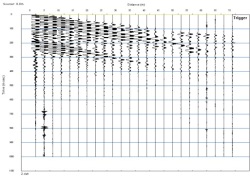 |
|
Click the image at left to see a video of the Thumper starting down the line. Here, a trigger switch is attached to the strike plate, allowing for automatic triggering of the Geode recording the signal from the geophones. In this video, Greg Chavez cycles the Thumper through two drops. The sound as the Thumper strikes the plate is audible. |
The new Thumper unit is currently being shipped to Nairobi, Kenya for its first active source project. The energy penetration capabilities of the Propelled Energy Source will allow PASSCAL equipment users to survey lower depths more accurately. Contact gchavez [at] passcal [dot] nmt [dot] edu (Greg Chavez at IRIS/PASSCAL) to learn more about the capability and availability of the PEG-40Kg.
- Home
- General Information
- Instrumentation
- Dataloggers
- Sensors
- All-In-One Systems
- Power Systems
- Field Procedures
- Controlled Sources
- Seismic Source Facility
- Magnetotelluric Systems at PASSCAL
- Ground Penetrating Radar
- Power and Memory Calculations Form
- Data Archiving
- Apply for a PI Account
- Experiment Scheduling
- Polar
- Important Hardware/Software Notes
- USArray
- Software

